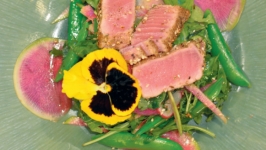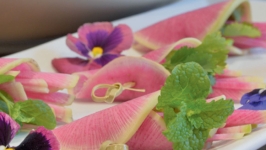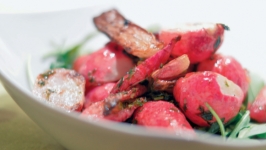You Have to "Dig" These Veggies
Roots are not something a “natural” blond like me wants to talk about. But as a chef, I love to hear the word. It may be hard, but it’s time to say goodbye to crisp just-picked peas, ripe summer tomatoes and succulent August sweet corn. That chill in the evening air means fall is upon us. Root vegetables are ready to harvest, making appearances in your CSA box, favorite farmers market or, if you’re lucky, that backyard garden you’ve been nurturing all summer. With their crooked features and unusual names, these late-garden gems lend an earthiness to your autumn cooking.
THE COLDER THE WEATHER, THE SWEETER THE ROOT
Root vegetables love that first frost. As the weather turns colder, those buried roots turn sweeter as the vegetable’s starch is turned into sugar.
Often overlooked and underappreciated, these unassuming vegetables are a virtual treasure chest of natural goodness. Root vegetables are a great source of beta carotene (a source of vitamin A), vitamin C, various minerals and dietary fiber.
What makes a root vegetable a root vegetable? True root vegetables are exactly that, the underground part of the plant. Think carrots, beets and radish.
But there are a multitude of other vegetables that are saddled with the root moniker.
There are rhizomes (ginger and turmeric) and tubers (jicama and potatoes) as well as corms (taro and Chinese water chestnuts). For the purposes of my root vegetable cooking, I throw them all into one big delicious vegetable basket.
Whatever label you give them, root vegetables are the perfect ingredient to transform a fall dish into something special.
TRY THEM RAW
A salad made of crunchy root vegetables? Don’t overlook the blend of unusual flavors and textures root vegetables can lend to an autumn salad.
Raw root vegetables give an autumn salad extra crunch and color. Try combining various colored beets and carrots with celeriac and parsnips. Use a mandoline slicer to cut the vegetables into thin strips.
Grab some other autumn-harvest goodies like Brussels sprouts and fennel along with those last greens of the season to round out the mix. For a dressing, make vinaigrette with hard pear or apple cider. And don’t forget the cherries. A generous handful of dried Montmorency cherries add just the right amount of sweetness to this rainbow-colored salad.
GIVE THEM A GOOD ROASTING
The heartiness and natural sugar from root vegetables make them the perfect choice for a nice roast in a hot oven.
Grab your favorite collection of peeled and cubed roots, toss in extra-virgin olive oil, give them a quick pinch of sea salt and pepper and you’re ready to roast.
A hot oven is key (400 degrees) along with a foil-lined baking sheet pan so you can provide the roots with a nice even area to roast.
A sprinkle of sugar over the mix will create a nice caramelized root vegetable.
For a gourmet yet easy presentation of roasted roots, grab some carrots. Look for a mix of colors. Carrots, like their root cousin the beet, come in a variety of vibrant colors.
Try mixing purple and yellow carrots with the more common orange variety. Keep the peeled carrots in one piece if thin, or cut lengthwise if thicker.
Roast as described above for about 13 to 15 minutes or until just tender when inserted with a paring knife. While the carrots are roasting, make a warm vinaigrette with toasted pepitas, sesame seeds, white wine vinegar, honey and olive oil.
For that restaurant look, whip up some feta, cream cheese and olive oil in a food processor and create a smooth, cool cream. Place a generous dollop on a plate, take the back of a spoon to make a chef-like swoosh across the plate and your carrot creation is almost done.
Place the carrots on top of the swoosh, drizzle with the warm nutty vinaigrette and you’ve got it. A fi ve-star restaurant presentation without the high price tag.
PUREE THEM
It’s time to bring out the soup pot and start simmering some heart-warming, feel-good pots of liquid gold. Soup and root vegetables make one nice marriage.
Almost any root or root combination can be made into a delicious soup. Puree the soup and the root’s starch content will make a creamy, thick bisque without a drop of heavy cream or roux made with flour.
Cherries may be the fruit of summer in our area, but come fall, it’s the apple that takes center stage.
Create a sweet and savory flavor combination by making a soup with parsnips and some of those just-picked autumn apples. No long simmering is needed; just enough time to make the parsnips soft enough to puree. Then a quick swirl in a blender or food processor and you have it. Top with a dollop of Greek yogurt or sour cream and a grind of fresh black pepper.
Roasted, steamed, pureed or eaten raw, those gnarly crooked-looking nuggets from the earth make this blond happy to have her culinary roots showing.
TYPES OF ROOT VEGETABLES
Root vegetables come in all shapes, colors and sizes. Some are familiar, like carrots and beets, and others, like celeriac and turnips, may seem like uninvited guests taking up room in your CSA share box.
Root vegetables tend to absorb toxins in the ground, so organic is always the best choice. Look for firm, blemish-free vegetables. Tops still on is the best. Often, the tops like in carrots and beets (see Edible Nation) can also be used along with the root.
The best place to store your root vegetables is in a dark, cool space – thus the name root cellar. If stored in the refrigerator, place in a paper bag and put them in a drawer to keep them firm. Onions and potatoes, however, should stay out of the frig and placed in a cool place in your kitchen.
Here’s some information on a few root vegetables to get you started in your autumn cooking.
BEETS – The beetroot is the taproot portion of the beet plant. Tolerant of cooler temperatures, these colorful beauties are a perfect fit for a Wisconsin vegetable garden. Plus, the greens as well as the root are edible.
With a wide variety of colors from golden and red to the pink and white-striped Italian heirloom variety known as Di Chioggia, beets are a must-plant in any home vegetable plot.
CARROTS – Carrots are well-known for containing the antioxidant beta-carotene which converts into vitamin A. But they also contain other great health benefits like potassium, calcium, magnesium and vitamins C and B6.
The colors of carrots are like the wheel of a color chart. The most common is orange, but these days you’ll find more and more carrot hues. Purple, red, yellow and even white carrots are often sold at farmer’s markets and at specialty stores, especially in the organic department. And the names are as varied as the colors. Don’t you just want to grab some purple haze, luna whites and atomic reds and toss them in a raw, colorful salad?
CELERIAC – Don’t be surprised to find celeriac in your autumn CSA share box. This gnarly-looking bulb may look a bit scary at first glance. But this edible root, sometimes referred to as celery root, is extremely flavorful and even has historical roots, pardon the pun. Mentioned in Homer’s Odyssey as selinon, celeriac originated in the Mediterranean Basin.
Although celeriac has a long shelf life of up to eight months, a freshly- picked vegetable will have a more distinct celery flavor.
PARSNIPS – Don’t think of parsnips as just pale-colored carrots. Although a relative of the carrot, parsnips have a unique taste all their own.
These cream-colored tuberous roots benefit from a little frost. The vegetable becomes sweeter as it rests snuggly in the ground, enjoying the lowered temperatures. Some farmers even overwinter their parsnip crop to concentrate this unassuming vegetable’s sweetness.
TURNIPS – Underappreciated and often unloved, turnips play well with other root vegetables. Large turnips are often used for livestock feed, but those small, just-picked small tender turnips make a perfect addition to an autumn stew, soup or oven-roasted vegetable mix. A good source of vitamins D, A and K, turnips are one of the few root vegetables that should be used when harvested as they can become woody when stored over an extended period.
KOHLRABI – Though not a root vegetable, kohlrabi is often cooked and stored like one. A member of the cabbage family, kohlrabi resembles a large bulb coming out of the ground with multiple shoots of leaves.
With a subtle sweet flavor, raw kohlrabi is often shaved or julienned, offering a little crunch to raw salads. The vegetable is also terrific cubed in a stir-fry or oven-roasted.
SWEET POTATOES – Yams or sweet potatoes: is there a difference? You bet. That perennial side casserole topped with marshmallow that has become a staple at so many Thanksgiving tables is no yam. It’s actually sweet potato.
Most people think that sweet potatoes and yams are the same thing. A true yam is a large starchy edible root that generally is imported to the United States from the Caribbean and Africa. Yams are also big. I mean really big. Often referred to as two-man, four-man or six-man yams (that’s how many men it takes to pick one up!) the largest recorded yam exceeded 600 pounds.
Sweet potatoes are from a completely different botanical family and have a higher sugar content and less starch than a true yam. Although orange is the most familiar sweet potato color, the root vegetable comes in a variety of hues from white, red and even purple.
In order to distinguish it from the white variety, sweet potatoes were referred to as yams (from the African word nyami) when they were introduced many years ago to grocery stores. Even through the USDA requires that the orange-colored sweet potatoes be labeled as sweet potatoes, they are still often marketed as yams.









